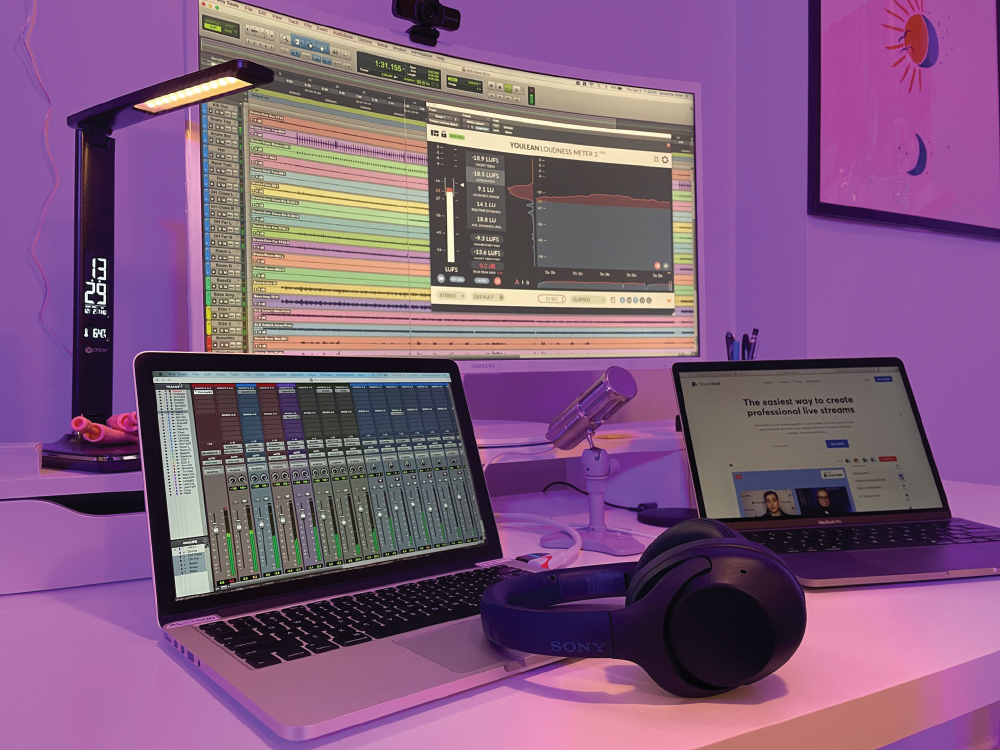Listen To This Article:
A dimension of audio streaming that often goes overlooked is the level at which the audio is being streamed and the effects the dynamics may have on it. Join me in this brief overview of loudness as it relates to streaming for live sound techs and mixers.
To put it simply, loudness is just an attempt to objectify a subjective experience. What I consider loud might not be loud to you at all and vice versa. Where “level” is objective, “loudness” is relative, subjective, and dependent on a whole host of variables including – but not limited to – duration, frequency content, and program content.
Different social media platforms (which is where most of us are likely streaming) are looking for different levels of loudness and quantifying it is no small feat. I’ll dive into what the different platforms are each looking for later in this piece, but for now, know that the level of the signal we’re streaming to the platforms has a large influence over how it sounds.
In a word: compression. However, there are two different uses of this term: 1) Dynamic range compression that most folks who mix audio are familiar with, and 2) Data compression so the audio (and video) can be transmitted over the internet more efficiently.
It’s the latter use of the term that we’re primarily discussing here. In order to send audio over the internet, the data is compressed using a lossless protocol (this means quality isn’t lost… allegedly), turned into bits to be sent to and from a server in some location (doesn’t matter where), and then out to the video players and news feeds of our audiences where it’s unpacked.
This compression, as noted, doesn’t affect the audio in an egregious manner. It’s really the other compression – of the social platforms. You see, if there were no loudness standards or no target at which to aim, everyone would just make louder and louder videos. It would be chaos! Eventually every video would become so loud that it would distort at any number of nodes along the signal chain of streaming.
Thus, there must be a standard of some kind, a “speed limit” to enforce. Somewhat arbitrarily, the platforms each have a rough range they want to “hear” the audio at, and if it doesn’t meet that standard, they make adjustments. But who’s to say they make these adjustments with care?
One more thing – we’ve covered the “why too loud is bad” aspect but another common issue is that streams can often be too quiet (because if you just take a console/mixer feed straight off the console, it’s likely going to be too quiet).
This can be just as problematic to audio quality as “too loud,” and it’s why a lot of folks do some sort of post-console processing to get the loudness to a more appropriate place for streaming.
LUFS & LKFS
Dynamic range is the span from the quietest sound to the loudest sound in a given period. Typically, the term is used to describe musical pieces (e.g., orchestras have large dynamic range, club music typically has low dynamic range). Dynamic range in streaming is less of a good thing. Consistency is key and the social platforms would rather kill the video and keep the audio running than the inverse.
Consistency also makes for easy listening. When the level fluctuates wildly it can be jarring and uncomfortable to people listening. Have you ever been in your car and one radio commercial was clearly much louder than the one before? It’s startling! Think about how people are consuming the service or the stream – headphones, earbuds, tablets, computers, TVs, etc. We don’t want to damage anyone’s hearing, so part of our goal is to keep things consistent.
If you’ve ever done any research on this topic you’ve no doubt gone down the rabbit hole of LUFS and LKFS. It’s a dark hole and goes on forever, seemingly.
LUFS (Loudness units relative to full scale) and LKFS (Loudness, K-weighted, relative to full scale) are two versions of the same scale – one of them (LUFS) just happens to be European. They’re a scale between -infinity and 0. If you see a number listed in LUFS but your software is listed in LKFS, it can be translated 1:1. By the way, I recommend checking out the Youlean Loudness Meter (youlean.co) and the MLoudnessAnalyzer (meldaproduction.com) free loudness metering plugins, both shown in Figure 1.

To put it simply, LUFS (and LKFS) are the “feels like” of loudness. The weather person may say it’ll be 95 degrees outside today, but if it feels like 105 degrees, that’s what I’m going to care about. The same logic applies. Because frequency content and program change so much and our hearing is so different from person to person and from frequency to frequency, we gauge it with this “feels like.”
Going a bit further, LUFS and LKFS are objective measurements designed to characterize how “loud” the material will be perceived by a human. In other words, the measurement itself is objective even though the goal is to approximate something subjective. In other words, it’s a measurement/algorithm.
Both have been derived from broadcasting standards. If you’d like to learn more, look up ITU-R BS.1770 and EBU R.128. The best part about these standards is that they reject sounds below a certain threshold (-70 dB LUFS) and don’t skew the averages. So, the liturgist walking off stage while the pastor walks on doesn’t count against us.
A general rule of thumb for streaming: aim for -16 LUFS/LKFS. If you read no further, that number can get you pretty far.
Stats For Nerds
YouTube has a very cool feature where they let you see the stats for every single video you have access to on the site. Go ahead, right-click on any video in its player and you’ll see “Stats For Nerds” as an option. It’ll give you way more information than you probably care to see but let me draw your attention to “Volume/Normalized.”
You’ll see that YouTube has normalized (adjusted to a certain level) and just after that it says, “content loudness,” which in Figure 2 is telling us was nearly 13 dB lower than what YouTube would prefer. That’s a huge adjustment, though most professional videos you find on YouTube likely hit in the +/- 1 dB range.

But this gives us a number! If the stream was too loud, it would be a positive number. Simply finding that “sweet spot” for the platform might take enough automation away from the platform (and onto us, because we know what we’re doing – right?) and let the platform have as little influence on the audio as possible. In addition, I check out streams and videos that I find are “good” to see how they land on the stats window.
Platforms
Pardon me while I adjust my soap box. Social media platforms survive via ad revenue. The more they know about you, the more valuable their data is which they in turn sell off to products and services that fit your data best. It behooves these platforms to give you as much access to their site for free. So, we get free streaming! Woo!
But it comes at a cost. Not monetarily, of course, but technologically, politically, spiritually, and so on. All of this is to say that social platforms that you pay nothing to be on owe you nothing and it is a first-come-first-serve world. Lots of entities are now streaming and to these platforms, you’re just one in 100,000.
It’s why sometimes your stream works perfectly and then 10 minutes later before downbeat you hit “publish” and the whole thing collapses despite nothing changing. They push out new releases without warnings, sometimes their services mess up, it can be 100 things or more that are completely out of your control. But the services are free so it’s hard to complain much.
Once you start paying for services, you can start creating and keeping expectations. You’ll also need to adjust them a tad because you won’t ever perfectly recreate an in-house mix. It just won’t happen. The technology isn’t there yet and more to the point, it’s a different experience altogether so perhaps it shouldn’t sound exactly the same.
OK, here’s the info that most people want. The target. YouTube, for instance, is pretty open about what their expectations are as far as loudness. Good luck finding others, like Facebook.
I had to do a lot of digging and researching to find these answers and I got them from Dolby (Figure 3). Notice that the maximum loudness in LKFS for Facebook, YouTube, and Vimeo are all different.

Key takeaways:
» Err on the side of quiet and manually turn it up as opposed to leaving it to the social platforms;
» It’s first come and first serve so don’t expect perfection every time;
» Consistency is important;
» Monitor your stream levels and make adjustments to see what sounds best on the platform(s) of your choice.




















